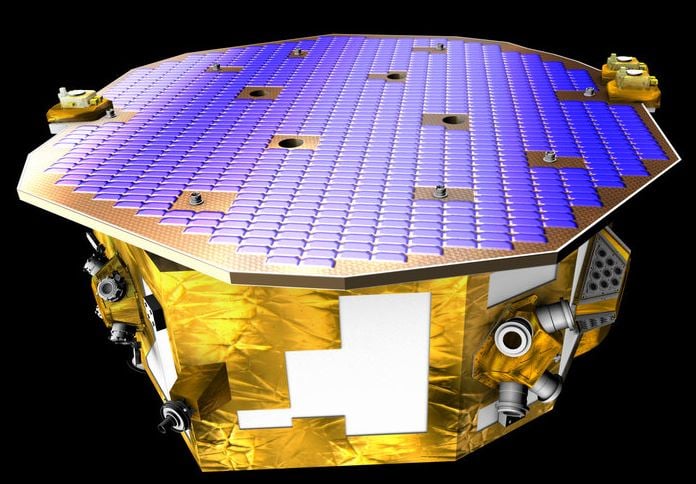Scottish scientists are loading special equipment they created into the LISA Pathfinder spacecraft to test an Albert Einstein theory – to detect ripples (low frequency gravitational waves) which can be caused, among other events, by two massive black holes merging.
The theory they aim to test formed part of Einstein’s Theory of General Relativity.
The rocket that will carry the kit created by researchers at the University of Glasgow’s Institute for Gravitational Research, will lift off on 2nd December.
According to team leader Dr. Harry Ward, the equipment, which is the result of over a decade’s worth of work, will be transported in the European Space Agency’s (ESA’s) LISA Pathfinder spacecraft, a space probe whose mission will be to test technologies required for the Evolved Laser Interferometer Space Antenna (eLISA), an ESA gravitational wave observatory scheduled for launch in 2034.
 According to ESA “LISA Pathfinder will test in flight the concept of low-frequency gravitational wave detection: it will put two test masses in a near-perfect gravitational free-fall, and control and measure their motion with unprecedented accuracy.” (Image: ESA)
According to ESA “LISA Pathfinder will test in flight the concept of low-frequency gravitational wave detection: it will put two test masses in a near-perfect gravitational free-fall, and control and measure their motion with unprecedented accuracy.” (Image: ESA)
The rocket will lift off from the Guiana Space Centre in Kourou, French Guiana.
Three satellites will attempt to detect the ripples
Dr. Ward and colleagues are sending three satellites, separated by several million miles, into space as part of their quest to detect these ripples.
About eight weeks after blast off, the spacecraft will reach its operating orbit, about 1.5 kilometres (932,000 miles) from Earth, towards the Sun.
According to the Institute for Gravitational Research:
“This will provide observations of low frequency gravitational wave sources, such as inspiraling massive black holes, extreme mass ratio inspirals and binary systems in our own galaxy.”
Dr. Ward hopes the mission will bring them closer to discovering direct evidence of the ripples.
 The Scottish scientists testing the optical bench. The optical bench of the LISA Pathfinder mission is the ultra-sensitive heart of a technology demonstrator mission which will pave the way for a future detector to measure gravitational waves. (Image: University of Glasgow)
The Scottish scientists testing the optical bench. The optical bench of the LISA Pathfinder mission is the ultra-sensitive heart of a technology demonstrator mission which will pave the way for a future detector to measure gravitational waves. (Image: University of Glasgow)
Dr. Ward commented:
“For the last decade, we’ve been working very hard on LISA Pathfinder, which is a tremendously exciting project involving researchers from all over Europe. It’s exhilarating and a little bit frightening that we’re finally on the verge of seeing it set off on the mission it was conceived to undertake and I’ll be lucky enough to see it from the launch site in Kourou.”
“The launch of the LISA Pathfinder is a major milestone, not just for us and the European Space Agency’s other partners, but for developing further our understanding of the Universe. It’s an exciting time to be working in this field and we’re looking forward to the next stage of the exploration of the gravitational Universe.”
Video – LISA Pathfinder
LISA Pathfinder’s name (Laser Interferometer Space Antenna), indicates the role of precursor that this mission plays. Its aim is to validate the technology needed to detect gravitational waves from space. Gravitational waves will improve our understanding of the Universe, and at the same time help to test Einstein’s General Theory of Relativity.
